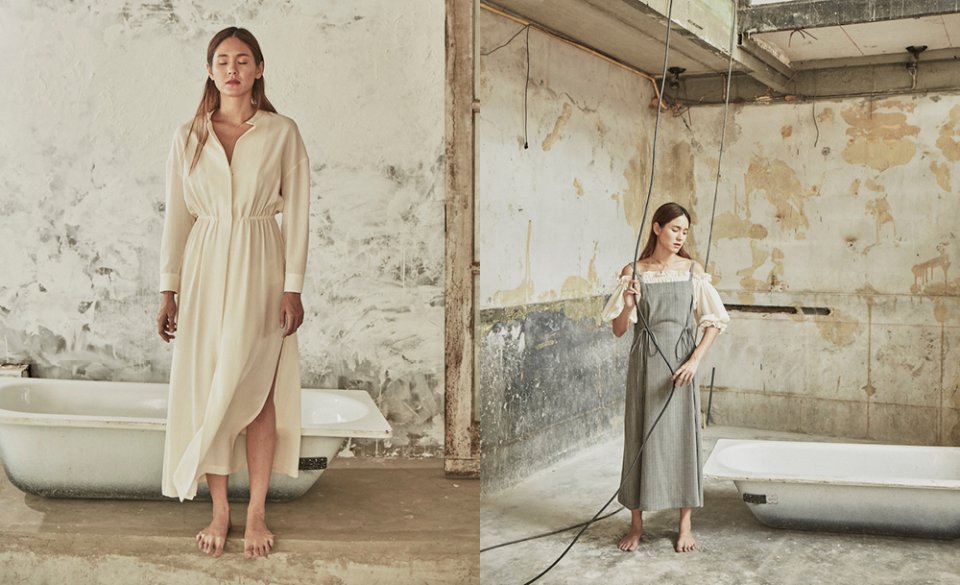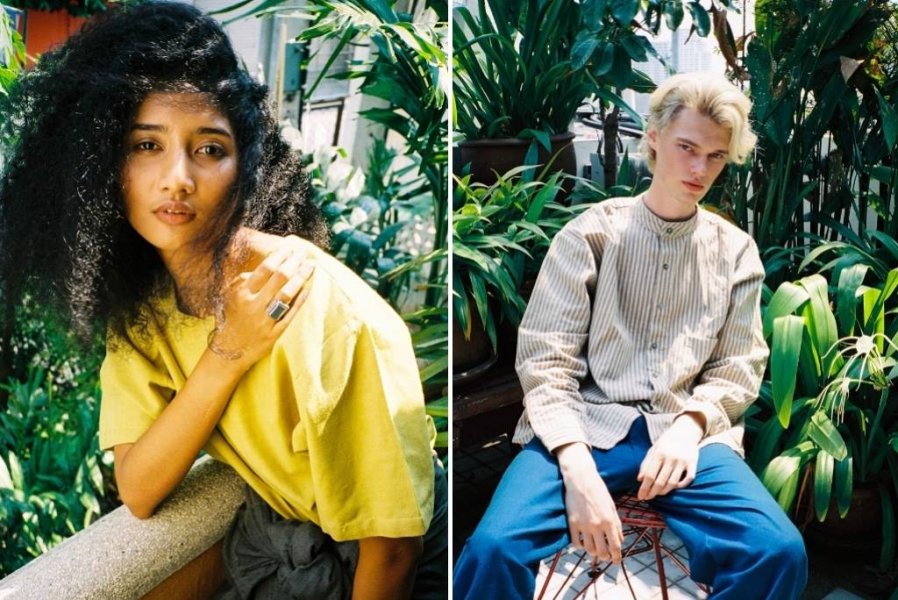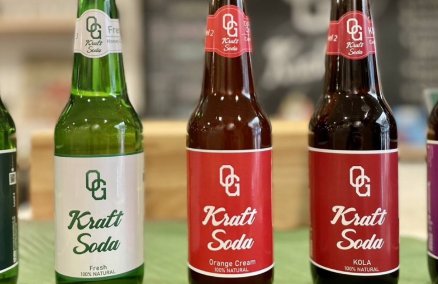At the end of this month, on a beach in Si Kao, the beautiful, white-sand coastal region of Trang just south of Krabi, Atelier Pichita will debut a fashion collection dedicated to the fabric craft skills of Southern Thailand. It’s the latest in a series of projects by Pichitra Boonyarataphan (whose eponymous label stretches back to 1980) which celebrate Thai fabrics, patterns and manufacturing techniques while interpreting them for an international audience. With editorials featured in luminary titles from Vogue to Harper's Bazaar, she has become one of Thai fabric’s leading flagbearers, selling locally produced silks and hilltribe patterns to the world.
Atelier Pichita
With her brand approaching 40, it feels like Pichitra’s work—driven by quality fabrics and a conscientious approach towards the craftspeople who produce them—has never been more relevant. As the latest collections of the spring/summer 2017 season attest, more and more Bangkok-based labels are embracing the country’s rich textile craft culture, replacing press-release buzzwords like “exclusive” and “luxury” with “artisan,” “local” and “conscientious,” while placing natural, Thai-made linens, cottons and silks at the core of their work.
“It’s commonly thought that Thai silk only suits boring, custom-made dresses in a single color or pattern,” says Pichitra, now aged 63. “That style has long been a hit for public school teachers and middle-aged women working in official positions, but here at Pichita, it’s not. I pick up on the exotic characteristics of Thai fabric and put them together to invent something cutting-edge.”
Pichitra Boonyarataphan
Pichitra picks up a jacket from her fall/winter 2016/17 collection, woven from an intricate cross-play of patterns taken from the borders of Northeastern sarong skirts formed from a single wrap-around tube of fabric, to illustrate her point. The design comes from a collaborative project between Pichitra and the Ministry of Commerce called "T-Style Isaan Object", for which she was challenged with finding new ways to develop fabrics produced in Thailand’s Northeastern provinces.
“The trip took me to several villages,” she says. “We worked together to spotlight Isaan textiles, and it was during that time that I recognized the beautiful borders on sarong. It suddenly came to my mind that these borders can be made into something new and intriguing.”
YOUTH APPEAL
Pang Sudhinaraset, head designer at Vickteerut, is also embracing local textile, using Thai linen to appeal to a younger clientele. In 2014, she launched a sister brand called Vick’s Weekend which draws on fabric-making skills from the North and Northeast of Thailand.
“I’ve seen lots and lots of Thai fabrics, mainly from the North and Northeast, that seem fit for casualwear and a younger target audience,” she explains. “We’ve always used imported fabrics for our main line. But for Vick’s, I just want to give these local fabrics a try.”
She reveals that the process has not been easy. “I have to be frank here,” says Pang. “Whether from the material itself or from unstandardized production, some of the fabrics we’ve received from these villages have quite a rough texture that’s not good for our customers. They’re not paying this not-so-low price to get harsh-feeling clothes.”
Her solution has been to mix local fabrics with those from abroad, like Japanese linen, while also realizing that, to make Thai textiles commercially viable, designers have to be willing to adapt. “You will see that not all pieces from Vick’s are made from fabrics from one country,” she explains. “We do have whole Thai linen tops, but then we also have shirts made from Japanese fabrics that introduce Thai elements, like a Thaimade waist strap. For me, this can at least be one way to continue supporting these fabric-makers.”
Vick's x Gyp Pokchat
With an upcoming collection co-designed with actress Pokchat “Gyp” Thaimchai, Pang hopes to spark greater interest in Thai textiles among a younger generation: “Gyp and I have known each other for a very long time. We share the same sense of style and, of course, she is another Thai-textile lover. So I invited her to join us. This will be a really great chance to bring an updated view of Thai textiles into the minds of teenagers. We all know that Thai kids look to celebrities to get their style cues.”
In addition to celebrity endorsements, Vick’s also holds workshops at her Ari boutique for customers to become acquainted with the process of Thai linen-making. “Some people come to our shops and wonder if the price of our products should be lower,” she explains. “Some even said that Thai-made fabrics from Thai brands should not have high prices. That’s why I decided that we should organize a workshop showing them how hard it is for Thai textile-makers; so the public can see the real value of these things.”
SUPPORT FOR THAI CRAFT
For Pichitra, supporting Thailand’s traditional craft industries is as much of an incentive as the fabrics themselves. “We can’t deny that the young generation in areas producing Thai textiles doesn’t want to do this as a career,” she says. “They don’t want to be weavers like their grandmoms. And when I have asked these old weavers if they would like to see their local textiles become industrialized, they also say no. So the future of this profession is quite uncertain.”
Yet there is still hope for the industry, according to Pichitra, thanks to new workshop initiatives appealing to a metropolitan audience. “There’s a workshop in the Sa-tuek district of Buriram which, although overlooked by many of the locals, is gaining a lot of attention from outside,” she says. “Many young people even fly from Bangkok to learn how to weave there. It’s apparent that there is still a certain group of people who are very interested in Thailand’s fabric heritage—and this is good for local tourism, as well.”
Nutthatida “Nan” Tohchoodee, age 28, is among a niche collective of young Bangkok fashion designers who are taking a fresh look at local fabrics. In Nan’s case, Thai cotton, which she initially discovered from a weaving collective while on a trip to her mother’s hometown in Northern Thailand.
“I noticed old folks in these areas wearing clothing made from local cotton,” she explains. “The fabric had a real artisan quality—textured and imperfect yet soft to the touch—but the silhouette which they were wearing was a bit stuck in the past. It gave me the idea to bring these fabrics into more modern territory.”
Seeker x Retriever
Under the brand Seeker x Retriever, Nan has combined her preference for modern, minimal styles with a design approach that puts the fabric first. Unisex shirts, trousers, tunics, blazers and dresses come in natural colors of indigo, white and gray (a color derived from takian tree leaves native to Lampang). Available only in small quantities (the hand-produced fabrics mean no two batches are quite identical), her clothing is now on sale in Bangkok, Australia and California, where it has found a home in artistically inclined stores like LA’s Mellore boutique.
MEETING INTERNATIONAL STANDARDS
Designer and fashion blogger Lauren Yates, the women behind
ponytailjournal.com and a regular contributor for Vogue Australia, has also fostered an international audience for designs which make use of Thai fabrics, specifically Chiang Mai indigo-dyed cottons and Northern silks. Called
W’menswear, her brand draws on the heritage of indigo workwear of various world cultures, and has become a huge hit in the craftsmanship-driven fashion markets of Japan, Taiwan and China.
W'menswear
“The way Japan behaves has always been quite unique,” explains Yates. “People really buy into the story of a product and the fabric, but they’re also incredibly QC [quality control] driven. My products have to be QC’d twice: once before leaving Thailand and once more when they arrive on Japanese soil.” This, she says, can be a problem when working with Thai fabrics. “To be honest, at the moment Thai textiles don’t always stand up, and it’s really hard to combat this problem. There’s just not the drive in the Thai scene to do anything about it. For example, my experience of Thai indigo is that there’s a lot of cutting corners—chemicals being added to natural dyes to cut production time.”
Yates now works with a small company in Chiang Mai called Slowstitch, founded by Bangkok native Kanchalee Ngamdamronkand her Russian partner, Sergey Tishkin, who create their own fabrics and products using natural indigo dye methods and a Japanese pattern-making technique called shibori.
“Slowstich is really working to try and raise the standard of indigo dye in Chiang Mai,” says Yates. “These guys use completely natural products for their own fermentation process. It’s a small project but every season I’ve made the commitment to produce something with them to help build the profile of Chiang Mai indigo into a world-renowned product. Already there’s been great feedback worldwide about the quality of the dying.”
Speaking from Chiang Mai, Serge from Slowstitch elaborates: “We work almost exclusively with Thai fabrics, trying to source as close to Chiang Mai as we can. We’re lucky to have a lot of cotton, hemp and silk here. Thai fabric can have an old-crafty feel; slubby [bumpy] cotton with imperfections that can be interesting. You have to have a balance between the imperfections and durability.”
Though Yates collaborates with Slowstitch for indigo dyework, the pair mostly work on their own collections of cushions, shawls and other decorative fabrics, which you can find on sale at Tamarind Village and Maiiam Contemporary Art Museum in Chiang Mai, as well as Labrador store in Bangkok’s Central Embassy. Soon, their products will also be available at Siam Discovery’s Thai design-focused O.D.S. concept store.
TRENDING DESIGN
Indigo has become something of a signature for brands specializing in Thai textiles. Originally founded a couple years back in New York by Thai designer Mel Sangsomsap, before she relocated to Bangkok, SSAP integrates local weaving and dying techniques into versatile streetwear and workwear. Its special Sakol Project was established especially to promote the natural indigo dying traditions of the Northeastern Sakol Nakorn province.
SSAP
Similarly, Praphaiphan Daengchai, a native of Sakol Nakorn province, last year worked with leading Bangkok design firm Thinkk Studio for her brand Mae Teeta. Together, they produced a contemporary line of items like dresses, T-shirts and jackets made from hemp, cotton and denim, as well as accessories like placemats and napkins. Aside from indigo, the brand derives its colors from locally harvested plants like mango and ebony fruit. New Bangkok label Parissara is also giving a contemporary spin to hand-woven cotton and silk, in the form of loose-fitting casual-wear in natural shades of indigo, vanilla and white.
Parissara
For an overview of all the ways in which a modern brands are putting Thai craft textiles to use, check out the International Innovative Craft Fair at BITEC this Mar 23-26, organized by the Support Arts and Crafts International Center of Thailand (SACICT, a project developed by Queen Sirikit which educates farming communities on traditional craft skills so they can support themselves with other industries in between harvests). While a lot of SACICT’s work results in the kind of throwback curios associated with the term “handicraft,” the Innovative Crafts Department works with some of Bangkok’s top young design minds on forward-thinking, contemporary products.
Running in conjunction, Bangkok International Fashion Week takes over the courtyards of Siam Paragon, Siam Center and Siam Discovery this Mar 21-26, when eyes will once again be trained on the world’s latest trends. This season, those watching the shows will do well to concentrate not just on how garments look, but how they're made. “Fabrics for fashion designers are like building materials to an architect,” says Yates. “Maybe to an untrained eye it’s about trends or style, but in my business it’s about touch and feel.”
Story by Kasidit Srivilai. Edited by Oliver Irvine.
Essentials
SSAP, available at Gin and Milk, 3/F, Siam Center. Or online at
www.onionbkk.com. Sakol Boro bomber is B3,580






















